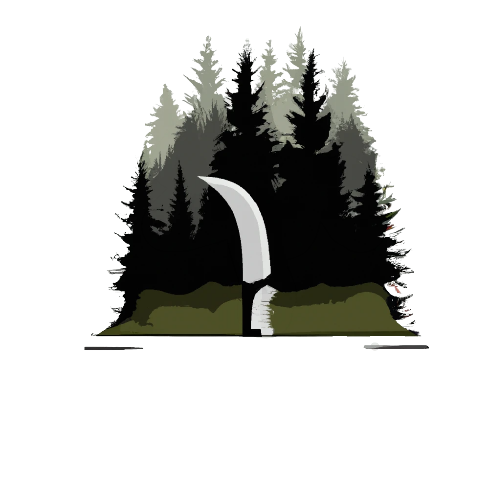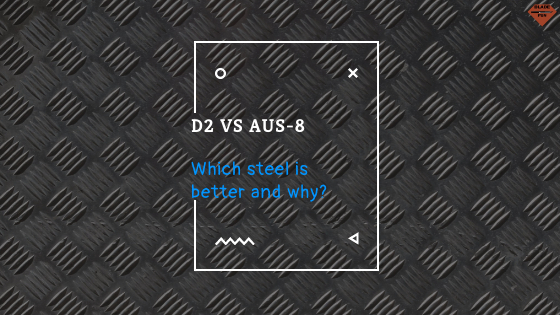D2 and AUS-8 are both very common steels. And while D2 is found more in high-end knives, they are both worth comparing. In this article, we will be taking a deep dive into which blade steel is better and why.
Here is the short answer:
D2 is higher-quality steel that is harder and has better edge retention than AUS-8, but D2 does not have as much corrosion resistance. AUS-8 is the opposite. So, if you’re looking for a cheaper, more water-resistant knife, go with AUS-8. If you want a high-end, less water-resistant knife, go with D2.
Now that you have the short answer, let’s take a deeper dive into the knife steels, like what they are made of, what their best applications are, and why you would want one over the other.
D2
D2 is a tool steel, which means that It’s got better edge retention and durability. Consequently, it’s a more expensive steel. Unlike AUS-8, D2 is not stainless steel, so to get good corrosion resistance (which is very tough with D2), you need to get a good finish, which will cost more money. Alternatively (or additionally), you can put oil on the blade to help protect it from corrosion.
D2 is primarily used for knives and tools. It’s a popular steel for tools because it hardens well, has high compression resistance, and can run for a long time.
The full composition of D2 is:
- Carbon: 1.5%
- Chromium: 12.00%
- Vanadium: 0.90%
- Molybdenum: 0.80%
- Magnesium: 0.45%
- Silicon: 0.40%
- Sulfur: 0.02%
Our favorite D2 knives
If you’re looking for a good D2 knife, here are some of our favorites:
The SOG Aegis AT
The SOG Aegis is one of our favorite SOG folding knives. It has SOG’s cryo D2 blade, assisted opening, and a safety lock. It has a GRN handle, which fits well in the hand.
You can check this knife out for yourself here (Amazon).
The SOG Terminus XR
The SOG Terminus XR also has a cryo D2 blade, SOG’s deep carry pocket clip, G10 handle scales, a thumb stud, and a flicker. The Terminus XR is more of an EDC knife, as it’s only 4 inches, closed, in length. The opening is also really smooth–made with the same technology as Benchmade’s previously patented AXIS lock technology.
Click here to see the knife for yourself (Amazon).
AUS-8
AUS-8 is a high corrosion resistant, high strength knife steel. Compared to other low-end steels, it’s pretty strong.
As far as applications go, AUS-8 is very popular among mid-price knife makers because it’s a cheaper steel, yet still has decent quality. AUS-8 is used mainly for machetes and knives. While it’s not quite as tough as D2, it’s still a good knife steel with good edge retention.
Here’s the full composition of AUS-8:
- Carbon: 0.75%
- Chromium: 14.5%
- Manganese: 0.5%
- Molybdenum: 0.3%
- Nickel: 0.49%
- Silicon: 1%
- Vanadium: 0.26%
Our favorite AUS-8 knife
Ontario Knife Company RAT
The RAT is one of OKC’s (Ontario Knife Company) most popular folding knives. It has a nylon handle, AUS-8 blade, a thumb stud, and a standard inner lock. This knife comes in all kinds of colors too, like bone, black, and forest green. It’s a reliable, standard knife.
Here’s the link for this knife (Amazon).
Which one is better
So which one is better? Well, it depends…
If you want a really durable knife with great edge retention and compression strength, then you’ll want D2. But, if you want a knife with great corrosion resistance, you’ll want AUS-8. Another factor to think about is the price. D2 knives are more expensive than AUS-8 knives.
So if you are diving or doing other activities where you will get your knife wet, then you want AUS-8. If you are going to be hard on your knife, but won’t leave it out in the elements for too long, you will want D2.
But why is D2 stronger than AUS-8? Well, D2 is easy to harden, making a stronger blade. D2 also has more elements that make it harder steel. With these factors, it makes it pretty easy to have a strong D2 blade.
On the other hand, AUS-8 is more corrosion resistant because it has approximately 14% chromium content. To be classified as a stainless steel, it must have at least 10%. With this high chromium content, this knife material lends well to not rusting.
Conclusion
Both knife steels have their upsides and their downsides; but at the end of the day, they have their set duties. While D2 is stronger than AUS-8, AUS-8 can withstand elements better. So before you buy a knife with one of these steels, make sure you know what you are using it for.
Find more knife-related blog posts like blade steel comparisons, knife reviews, and everything else knife-related here!

